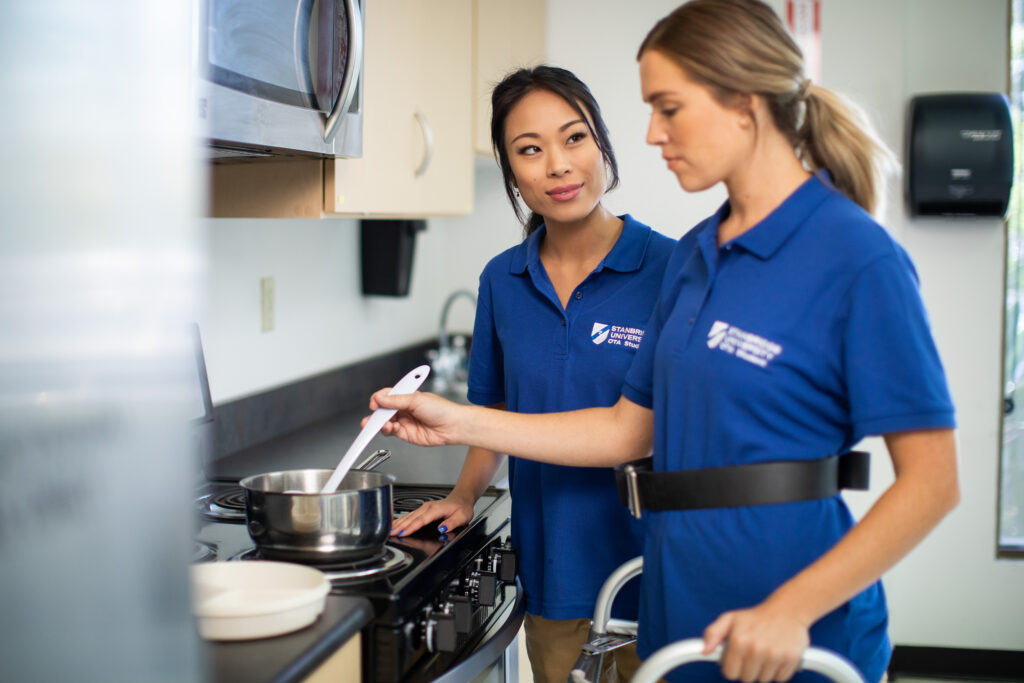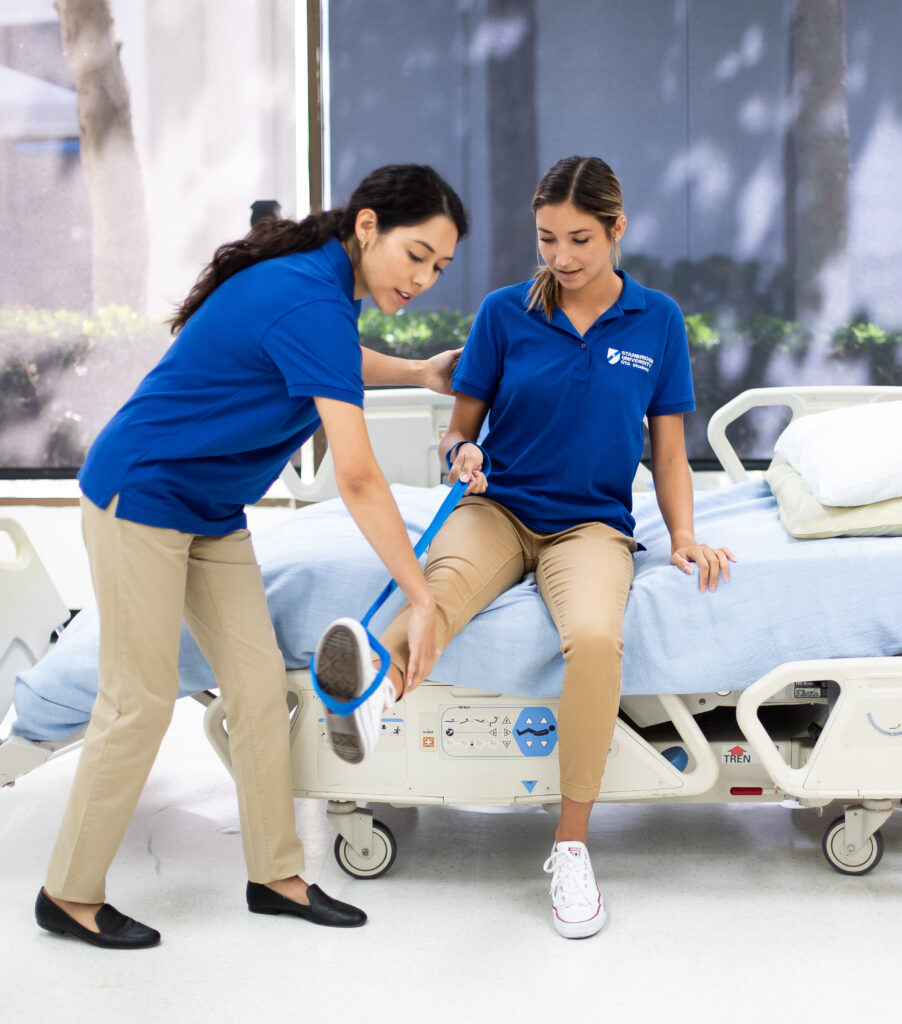Inside the Role: What Occupational Therapy Assistants Really Do

Helping someone rebuild their life after an injury or illness takes more than treatment. It takes teamwork, connection, consistency, and care. Occupational Therapy Assistants (OTAs) are vital to that effort. What does an occupational therapy assistant do?
According to the Bureau of Labor Statistics, Occupational Therapy Assistants (OTAs) work under the supervision of licensed Occupational Therapists (OTs) to help patients rebuild their ability to perform essential daily tasks. From learning to dress independently to strengthening mobility after surgery, OTAs are there every step of the way.¹
So, what does an occupational therapy assistant do exactly? They translate therapy plans into action, providing the personalized, hands-on care that supports real progress.¹
What Does an Occupational Therapy Assistant Do?
An Occupational Therapy Assistant (OTA) helps patients of all ages recover from injuries, illnesses, or disabilities by assisting them with daily tasks such as eating, dressing, and grooming. The occupational therapy assistant job description includes helping patients use therapeutic techniques and adaptive tools to improve their ability to function independently at home, work, or school.¹
OTAs work under the supervision of licensed Occupational Therapists (OTs) in various settings, including hospitals, rehabilitation centers, outpatient clinics, schools, and home healthcare, bringing therapy to patients wherever it’s needed.¹
Daily Occupational Therapy Assistant Responsibilities
The daily OTA responsibilities include helping patients practice exercises that build strength, mobility, and confidence. OTAs play a hands-on role in guiding patients through routines that improve their ability to dress, eat, and manage hygiene independently.¹
They also adjust assistive devices like splints or braces, observe patient progress, and communicate updates to supervising therapists. While Occupational Therapists develop the treatment plans, OTAs bring them to life through practical, one-on-one care.¹

Soft Skills That Set OTAs Apart
A successful OTA must bring more than clinical knowledge. They need patience to support slow progress, compassion to understand emotional challenges, and attention to detail to follow treatment plans accurately.
Adaptability is also key, as every patient has different needs and goals. Strong communication and emotional awareness help OTAs connect with patients in ways that build trust and encourage effort. These key traits of occupational therapy assistants are often what make recovery feel possible for the people they help.
Where Do OTAs Work?
OTAs are employed in a wide range of healthcare settings. In acute care hospitals, they assist patients recovering from major surgeries or medical events. In long-term care facilities, they help residents maintain or regain basic abilities. OTAs also work in outpatient clinics, providing short-term rehab, and in early intervention programs, where they support children with developmental delays.¹
The demand for OTAs is expected to experience faster-than-average growth due to an aging population and increased need for rehabilitation services². As demand for rehab services grows, particularly among aging populations, OTAs are finding more opportunities to specialize. Exploring the OTA career path can lead to roles in pediatric care, geriatrics, mental health, or even administrative leadership within therapy teams.¹
OTA Career Path: Education and Training Requirements
To become an OTA, individuals typically complete a program that includes coursework in anatomy, therapeutic techniques, and hands-on fieldwork. To practice, graduates must pass the national certification exam and meet state licensure requirements.
Stanbridge University offers an Occupational Therapy Assistant program designed to provide students with both theoretical knowledge and hands-on clinical experience. The program consists of 112.5 quarter credit hours and typically takes 22-23 months to complete, depending on individual progression and cohort start dates³. Students will engage in a combination of on-ground, online, and blended learning environments. Labs take place on campus, and fieldwork occurs at various healthcare facilities.
Financial aid is available for those who qualify, and Stanbridge University’s Student Services department provides career services to support students in job placement and career preparation.
A Meaningful Career in Healthcare
What does an occupational therapy assistant do? They provide steady, compassionate support that helps patients reclaim their independence.¹ With a unique blend of clinical skill and human connection, OTAs make a measurable difference in people’s lives every day. If you’re seeking a hands-on role in healthcare that’s both impactful and rewarding, the OTA career path offers a future filled with purpose.
Interested in pursuing a meaningful and rewarding career as an Occupational Therapy Assistant? Find out how the OTA program at Stanbridge University prepares you for the role.
Frequently Asked Questions
They provide steady, compassionate support that helps patients reclaim their independence. With a unique blend of clinical skill and human connection, OTAs make a measurable difference in people’s lives every day.¹
OTAs are employed in a wide range of healthcare settings, including acute care hospitals and long-term care facilities. In acute care hospitals, they assist patients recovering from major surgeries or medical events. In long-term care facilities, they help residents maintain or regain basic abilities.¹
An occupational therapy assistant (OTA) works under the supervision of a licensed occupational therapist to help patients perform daily activities like dressing, eating, and grooming. They guide therapeutic exercises, adjust assistive devices, and monitor progress to support recovery and independence.¹
OTAs need strong communication, patience, adaptability, and attention to detail. These soft skills, combined with clinical knowledge, help them follow treatment plans accurately and connect with patients in a supportive, motivating way.
OTAs work in hospitals, rehabilitation centers, outpatient clinics, schools, and home healthcare. Some also specialize in areas like pediatrics, geriatrics, or mental health, depending on their career interests.¹
The Occupational Science in Occupational Therapy Assistant program at Stanbridge University typically takes 22–23 months to complete, depending on the student’s progression and cohort start dates.³ Graduates must also pass the national certification exam and meet state licensure requirements.
Yes. OTAs are in high demand, with faster-than-average job growth expected over the next decade. The role offers a hands-on, meaningful way to make a difference in patients’ lives while providing strong career stability.²
Footnotes
¹Source: Bureau of Labor Statistics, U.S. Department of Labor, Occupational Outlook Handbook, Occupational Therapy Assistants, https://www.bls.gov/ooh/healthcare/occupational-therapy-assistants-and-aides.htm. As viewed on August 8, 2025.
²Source: Bureau of Labor Statistics, U.S. Department of Labor, Occupational Outlook Handbook, Occupational Therapy Assistants, https://www.bls.gov/oes/2023/may/oes312011.htm. As viewed on April 14, 2025.
³Program duration subject to change. Completion times vary depending upon the start and end dates of a cohort and any individual circumstances that may impact progression.
